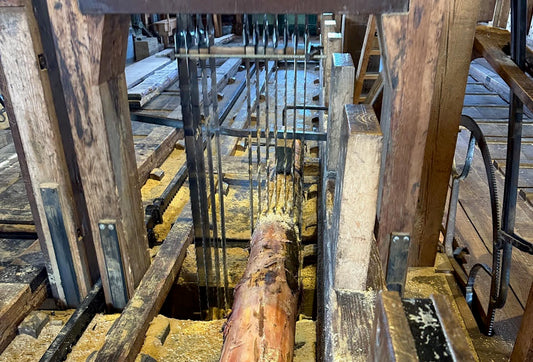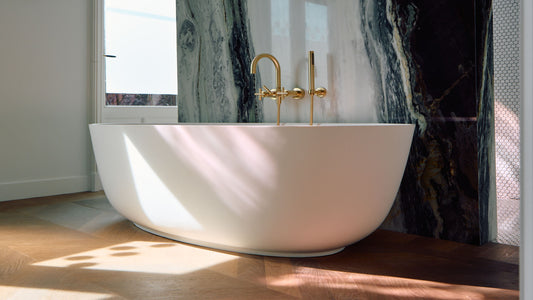Vloerbedekking

Datum: 17 augustus 2023
Leestijd: 6 minuten
Auteur: Uipkes Houten Vloeren
Carpeting, also known as floor coverings, has always played an important role in the interior of buildings. Over the years, numerous types of floor coverings have been developed, each with its own characteristics and benefits. Below we delve into the history and properties of different types of floor coverings.
Bezoek de showroom
History Of Floor Covering
The history of floor coverings goes back a long way. The very first floor coverings were probably natural materials such as animal skins and straw. As societies developed, the need for more comfortable and durable flooring solutions increased.
Antiquity
In ancient civilizations, such as the Egyptians and Greeks, stones or tiles were used. In wealthier families these were decorated with mosaics and other artistic designs.
Middle Ages
In the Middle Ages, carpets became popular, especially in wealthy households and palaces. These were often hand-woven and showed complex patterns.
Modern time
With the Industrial Revolution in the 19th century, machine-made floor coverings such as linoleum were invented. The 20th century saw the rise of synthetic materials, leading to a variety of floor covering options.
Magazine Vol inspiratie
Types of Floor Coverings and Their Properties
Wood (Parquet, Parquet, Solid Wood)
Wooden floors are synonymous with classic beauty. They have been enriching homes with their warm and natural appearance for hundreds of years. From traditional oak to exotic teak, wood offers a wide range of colors and patterns with which you can create any atmosphere you want. Nowadays, wooden floors suitable for underfloor heating.
- Properties: Warm, natural, durable
- Application: In private and commercial projects.
Carpet
Carpet, one of the most traditional types of floor coverings, is known for its softness and comfort. For centuries, carpet has offered a feeling of warmth and coziness to spaces. Over the years, technological advances have created diverse textures, patterns and colors, meaning carpets now fit a range of interior styles.
- Properties: Soft, warm, sound-absorbing, available in many patterns and colors.
- Application: Living rooms, bedrooms, offices.
Tiles (Ceramic & Porcelain)
Tile floors have their roots in ancient civilizations such as the Egyptians and Romans, who refined the art of making and installing tiles. Ceramic and porcelain tiles are both durable and stylish, and they provide a cool, sleek surface that is especially appreciated in warmer climates.
- Features: Durable, water resistant, easy to clean.
- Application: Bathrooms, kitchens, hallways.
Natural stone (Marble, Granite, Slate)
Natural stone is the embodiment of timeless elegance. Stones such as marble and granite have adorned palaces and temples over the centuries. These floors are not only aesthetically pleasing, but also incredibly durable, adding a touch of natural beauty to any space.
- Properties: Hard, cold, luxurious appearance, durable.
- Application: Entrance halls, bathrooms, kitchens.
Laminate flooring
Introduced in the 20th century, laminate flooring offers the look and feel of natural materials, but at a fraction of the price. With its resistance to scratches and stains, laminate offers a low-maintenance solution for modern households.
- Properties: Durable, cost-efficient, imitates natural materials.
- Application: Living rooms, bedrooms, offices.
Linoleum
Linoleum, often confused with vinyl, is an all-natural floor covering made from linseed oil, resin, limestone and cork powder. With its retro look and environmentally friendly properties, linoleum is making a comeback in contemporary interiors.
- Properties: Natural material, durable, wear-resistant, available in many colors.
- Application: Schools, hospitals, offices.
Vinyl
Vinyl is a versatile and cost-efficient floor covering. Developed in the 20th century, vinyl offers a water-resistant and durable solution that is available in many designs. It is a popular choice for both domestic and commercial spaces.
- Features: Water-resistant, soft, durable, available in many designs.
- Application: Kitchens, bathrooms, commercial spaces.
Cork
Cork floors combine comfort with durability in a unique way. Made from the bark of the cork oak, this floor covering provides a soft and warm surface that also dampens sound. Cork is both environmentally and aesthetically pleasing, making it a popular choice for environmentally conscious homeowners.
- Properties: Soft, warm, sound-absorbing, durable.
- Application: Living rooms, offices, libraries.
Cast floors
Cast floors, as the name suggests, are poured directly onto the surface and offer a seamless and sleek finish. Originally introduced in industrial and commercial settings for their durability and easy maintenance, cast floors have now found their way into modern homes thanks to their sleek look and versatility.
- Properties: Hard, cold, moisture resistant, sleek finish.
- Application: toilets, bathrooms, kitchens, industrial halls.
PVC Floors
PVC floors, often referred to as vinyl planks or luxury vinyl tiles (LVT), are relative newcomers to the floor covering market , but have quickly gained popularity due to their water resistance, versatility and maintenance-free properties.
- Properties: Maintenance-free, wide range, water-resistant
- Application: Living rooms, kitchens, halls, offices, libraries.
Thuis advies ontvangen?
Ecological Considerations
At a time when sustainability is becoming increasingly important, many people are opting for floor coverings that are both sustainable and environmentally friendly.
- Wooden floors: Wood, together with wool, is one of the few renewable raw materials. This makes the floors, from well-managed forests, sustainable. Storing CO2 also contributes to this.
- Cork: As previously mentioned, cork is harvested from the bark of the cork oak without damaging the tree. This makes it a renewable and environmentally friendly resource.
- Linoleum: Made from completely natural materials, linoleum is biodegradable and has a low carbon footprint.
Installation methods
Depending on the type of floor covering you choose, installation methods vary:
- Floating Installation: Many laminate floors use a click system that allows the planks to fit together easily without the need for glue or nails.
- Bonding: Carpet, wood, vinyl and some types of linoleum require an adhesive to stay in place.
- Nailing or Stapling: Traditional hardwood floors are often nailed to the bottom surface.
Maintenance tips
- Carpet: Vacuum regularly to remove dirt and debris. Stains should be treated immediately to avoid permanent damage.
- Stone tiles: Mop with a pH neutral cleaner and ensure a good seal against stains.
- Wood: If properly treated, wooden floors can be mopped with floor soaps specifically designed for wooden floors.
Inspiratie & Informatie
Future Trends
- Sustainability: In addition to traditional materials, there are more and more innovative, recyclable or biodegradable floor covering options on the market.
- Smart Floors: With advances in technology, there are developments in floors that can integrate with the occupant, such as floors that measure air quality or even generate energy with every step.
- Adaptable Design: Modular flooring systems that can be easily replaced or adapted to new interior trends are on the rise.
Floor coverings continue to develop and adapt to the needs and wishes of consumers, where aesthetics, functionality and sustainability often go hand in hand.
Vragen? Kom langs voor advies!
Frequently Asked Questions
What are the different types of floor coverings that have been popular throughout history?
Over the years, several types of floor coverings have become popular, including animal skins and straw in the earliest times, stone and tile with the Egyptians and Greeks, hand-woven carpets in the Middle Ages, and machine-made floor coverings such as linoleum during the Industrial Revolution.
What are the main properties and applications of tile floors?
Tile floors, such as ceramic and porcelain tiles, are durable and stylish. They are water resistant and easy to clean. These floors are often used in bathrooms, kitchens and hallways.
Can you name some eco-friendly flooring options?
Yes, some eco-friendly flooring options include:
- Cork, which is harvested without damaging the tree;
- Linoleum, which is biodegradable and made from natural materials;
-Wood, which is a renewable raw material and stores CO2;
How do installation methods differ for different floor coverings?
Installation methods vary depending on the type of floor covering. Laminate floors often use a click system for floating installation without glue or nails. Carpet, vinyl and some types of linoleum require gluing, while traditional hardwood floors are often nailed to the underside.
What are some future trends in floor coverings?
Some emerging trends include an emphasis on sustainability with recyclable or biodegradable options, smart floors that integrate with the occupant by, for example, measuring air quality, and modular flooring systems that can easily be adapted to new interior trends.
Stay up to date with news about floors and interior





